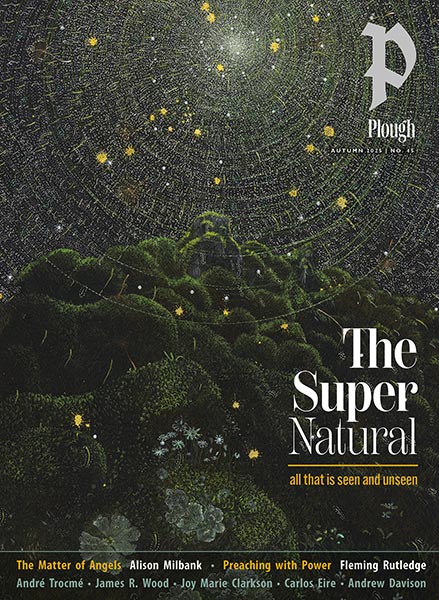Subtotal: $
Checkout-

All About Light
-

Making a Work of Art
-

The Business of the Artist
-

The Creative Process
-

Return to Appalachia
-

Excerpt: Mandela and the General
-

Why We Live in Community: A Manifesto
-

Editor’s Picks Issue 18
-

The Sacred Bonds of Sound
-

Making Music for Community
-

A Man of Honor
-

Wassily Kandinsky
-

Giant Picnic
-

Covering the Cover: The Art of Community
-

The Art of Community
-

Readers Respond: Issue 18
-

Family and Friends: Issue 18
-

I Did Not Leave
-

Summer of the Tree House
-

Warriors on Stage
-

The Beauty of Belonging
-

Insights on Beauty

It Could Be Anyone
A Muslim writer contends with two Christian paintings
By Navid Kermani
November 5, 2018
I
My Catholic friend has written papers, only one of which I have read, about how he came across this picture. He would not exclude the possibility that it was painted by none other than the evangelist Luke. No laboratory analysis of the wood has been performed to date. The nuns are reluctant, he writes, because it’s so brittle. But, even so, art historians have declared the painting definitely ancient, probably first-century. Ageless, the Virgin looked upon me, too.
My friend drove me to the convent, located on an ordinary residential street on Monte Mario, across the Tiber near the Hilton, and asked for the key at a little hatch in the side wall while I waited in the car. Before he led me to the chapel, where the nuns had turned the picture around for us, he peed in the bushes beside the iron gate. Ordinarily the Virgin looks into the oratorium of the nuns, who have cloistered themselves away for life, neither receiving visitors nor traveling, nor even leaving the convent to walk to the shops. God suffices.
We saw a few of them through the barred window in which the picture is hung, and we heard all of them praying in the wan light, wimples past their chins, starched white habits, black veils. Five of the thirteen sisters are over eighty. Those sitting in the section of the pew that I could see through the window were no younger. Vast water stains stood out on the bare walls of their baroque church. My friend said the pipes were rotting, the phones didn’t work, and repairs were out of the question until the convent had paid off its debts. The plea for donations is the part of their prayers that has yet to be fulfilled.

After a few minutes the nuns put out the light, after which we could only hear their voices: one verse low, one verse high, a singsong interspersed with pauses, although I couldn’t make out a word. My friend’s book begins with a quotation from the retired pope: what it says is nothing new but always needs to be said anew. “Great things do not get boring with repetition. Only petty things call for variety and need to be changed quickly for something else. What is great grows greater still when we repeat it, and we grow richer, and become calm, and free.” In Rome I was already growing envious of Christianity, envious of a pope who said sentences like that, and, if I hadn’t thought the idea of God’s incarnation in only one person fundamentally wrong and the world of Catholic concepts in particular so pagan, if I hadn’t felt such a revulsion against the order that places all people and all human relations in hierarchies and against the demonstration of power in every Catholic church, not to mention the idolization of suffering to the point of bloodlust, I might possibly have gradually adopted its practices, attended the Latin Mass, and joined, with interspersed pauses, in the singsong, although initially more for aesthetic reasons, perhaps, and out of a fascination with the unparalleled continuity of an institution that forms the people of God into a community. It is the only one to have achieved that for so long. Who knows? Maybe the miracle that produced this most sumptuous of all heavenly houses might one day have manifested itself to me too. As it is, while I continue to consider that this possibility is not reality, I acknowledge – and what’s more, I feel – that Christianity is a possibility.
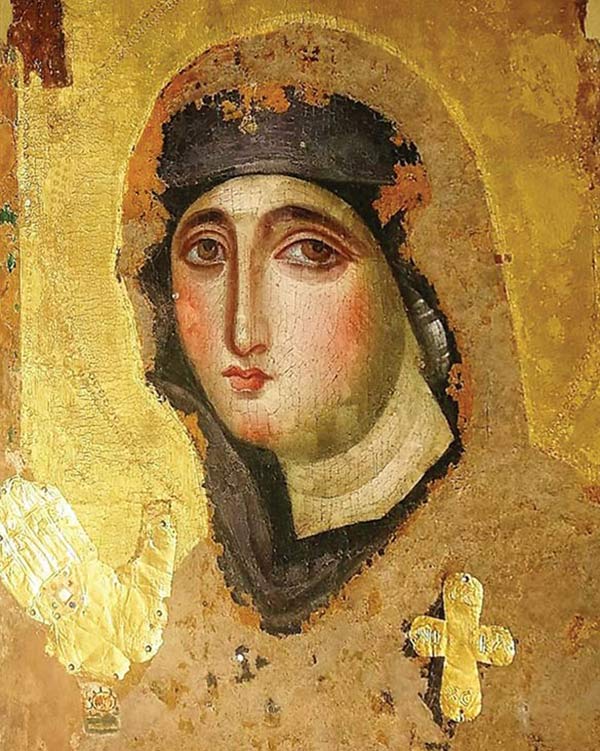
A late classical icon of Mary the Advocate in Santa Maria del Rosario Church in Rome
As if the darkness were not seclusion enough, invisible hands closed the shutters from inside so that we now saw only the icon, not the room behind it. Nothing is extant but Mary’s face in the most astounding colors, the edge of her veil, two gilt hands, which could be pointing a way or signaling aversion, and the cross at the position of her heart – nothing else but her silhouette. And of course the gold background! The icon painters call it “light,” my friend whispers, because the gold surrounds the saints like the light of Heaven. There is no side lighting, no imagined light source; instead, the colors themselves are light, and the lightest of them is the gold. As my friend withdrew to say a rosary, I had some time with the Virgin. But why do I call her Virgin if I don’t believe in her as the Mother of God? One word: touched. God has touched her. That is both grace and torment; it raises up and strikes down; it is both a caress and the blow of a hammer. All is lost and God suffices.
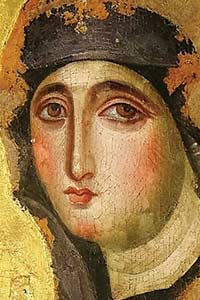
Her big brown eyes look at you as if her much smaller mouth had cried at first, like the mystic Hallaj, “Save me, people; save me from God.” And so she did at first; she cried for help when she found out, I’m certain she did. “Glad tidings!” the kings bellowed, bringing gifts, but I am certain she was anything but glad. She carried it, bore it, as the saints bear it; that’s what made her one – not being chosen, but being able to stand it. Having become an enemy of the state overnight, she fled, sleeping in barns, in cellars, and in the wilderness if necessary – it was a real wilderness two thousand years ago – her child always with her, and always her care, which was not increased or diminished by the question whether he was a or the son of God. Her care was that of every mother. Later she stood by as they struck him in the face, drove him with whips through the spitting mob, saw the thorns piercing deep into his brow, saw him carrying the cross, saw them nail him to it, saw the cross erected and the people jeering, saw her son hanging upon it, bleeding, groaning, thirsting, crying out in pain and despair hour after hour. Perhaps he was not the only one to look toward heaven and ask why God had forsaken him. Certainly the son looked down from the height at which the people displayed him towards his mother. Does the painting show her before or after that?
Already a subscriber? Sign in
Try 3 months of unlimited access. Start your FREE TRIAL today. Cancel anytime.
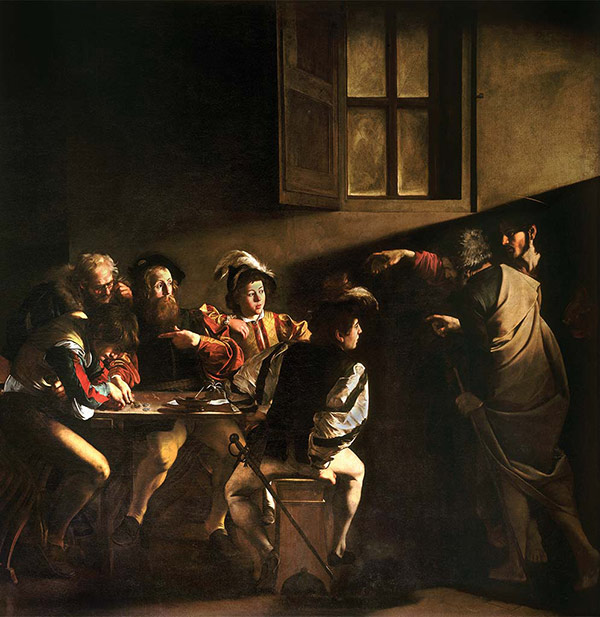
Michelangelo Merisi da Caravaggio, The Calling of Saint Matthew, 1599–1600, oil on canvas
II
It could be anyone, any of the four men sitting around the little table, or the boy. It could be now, as Caravaggio teaches us by dressing the biblical crew, as today’s auteur theater directors would, in contemporary costumes, contemporary to Caravaggio that is, the apostle in frills. Levi, as Matthew is still called in the Gospels of Luke and Mark, is so deep in concentration on counting the taxes he has collected today that he has not yet noticed the stranger pointing at him, or else he has noticed and is not looking up because he refuses to believe it. Or is a different one Levi? For four hundred years the viewers have not been able to agree even on that, sometimes identifying the bearded man as the future apostle, sometimes the one counting the money, seeing the three index fingers as pointing sometimes at the one, sometimes at the other. Apparently it’s a matter for each observer to decide, and I should therefore ask myself why, from the first glance, I saw the one who is paying the least attention to the Savior as the one chosen. Jesus’ companion Peter, in any case, seems to be reassuring the other tax collectors that he doesn’t mean them; they can go on collecting taxes, day in and day out, feeding their families by preying on other families, leading ordinary human lives.
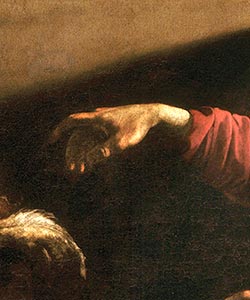
Only to Levi Jesus says, “Follow me!” Not a word more does the Bible tell us about the vocation of Matthew: no reason, no explanation, and least of all any preaching or proselytizing, only: “Follow me!” And Matthew arose and followed him. In the Bible, the break with everything that had made up Levi’s life up to that second is so abrupt and total that it can be understood – if not trivialized as hypnotism or clouded by the word charisma – only as a miracle. But Caravaggio is not interested in the miracle itself, because it cannot be represented, or if it can, it suddenly looks comical or in any case unnatural, as it did the one time he himself painted it, in the picture of doubting Thomas sticking his finger in Jesus’ side as if it was full of air. Caravaggio is interested only in people. Of all painters he has the keenest eye for what the appearance of the Celestial means to terrestrials: it blows them apart. Caravaggio’s pictures show, not revelation, but many variations on the torment of those to whom it is revealed; anyone who has once lost himself in his paintings would not call it “glad tidings.” “If you knew what I know, you would laugh little and weep much,” says the Islamic Prophet, who foamed at the mouth and thrashed about in pain when the angel appeared to him, so that many thought he was possessed, epileptic, or mentally ill. “Is not my word like as a fire? saith the Lord; and like a hammer that breaketh the rock in pieces?” says the prophet Jeremiah (23:29).
The finger could point at anyone, at any time.
In The Calling of Saint Matthew, Caravaggio captures, just once, the moment immediately before the calling, not the fact of being called. The picture itself offers no clue as to what is about to happen – which is what defines the situation. Of the five people sitting or standing around the table, Levi is the last one you would imagine, if you didn’t know, as the man walking off after the stranger, his eyes glassy and his mouth hanging open like a sleepwalker’s. Or, because the man counting money at the left is not necessarily Levi, perhaps we should say rather that you can’t imagine it of any of them. That would mean that any person could be chosen. “Really, him?” asks the bearded man, while his bespectacled neighbor finds the coins more interesting. Or else, as other viewers have thought, the bearded man is saying, “Really, me?” The man in the foreground with the feather in his hat seems to understand nothing at all. He looks at Jesus only because the boy is kicking his shin under the table: “Yeah, what about it?” If you only look at the four men and the boy, covering up Jesus and Peter with a sheet of paper if you like, you can imagine all kinds of things drawing their attention – a fight at the next table, the innkeeper collecting a tab, or a superior calling them to duty – but not the Redeemer in person approaching. Their amazement is not great enough for that; it’s really just a sitting up and taking notice, a “What do you want?” That would mean the miracle is not the appearance of the Savior; the miracle is that someone notices it – and, if I am not mistaken, it is the one who pays the Savior no attention at all. The men will be stunned only when their colleague, from the next moment to the moment after that, abandons his family, his profession, and his view of the world.
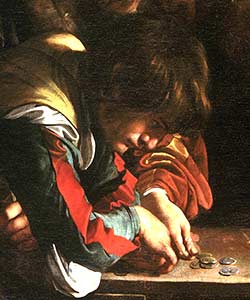
That is Caravaggio’s calculation in using contemporary clothes and the ambiguous direction of the pointing finger; that is his agenda in conceiving The Calling of Saint Matthew as one painting in a cycle that decorates a side chapel of the church of San Luigi dei Francesi in Rome. As if in warning, The Martyrdom of Saint Matthew on the opposite wall portrays where the calling leads. The cycle originally consisted of just these two paintings, which sufficed to state the essentials of the saint’s life: random choice and sacrifice. The finger could point at anyone, any time. The door behind me could open and the person standing there could blow my life apart – the motif that German Romanticism loved: I had just left the house, not a thing on my mind, when suddenly … except that most of us are the others, the three other men and the boy, who watch the miracle happening and don’t see it.
This article is excerpted from Kermani’s book Wonder Beyond Belief: On Christianity, translated by Tony Crawford (Polity, 2017). Used by permission of the publisher. politybooks.com

This article is excerpted from Kermani’s book Wonder Beyond Belief: On Christianity, translated by Tony Crawford (Polity, 2017). Used by permission of the publisher. Get the book.
Already a subscriber? Sign in
Try 3 months of unlimited access. Start your FREE TRIAL today. Cancel anytime.





